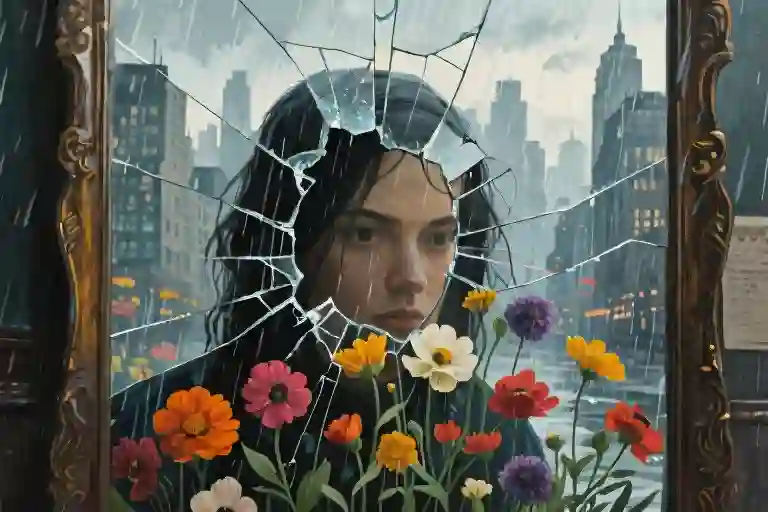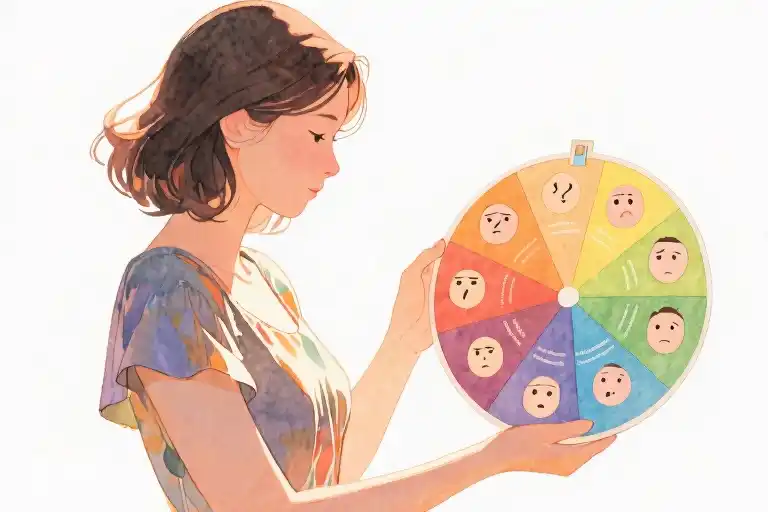The world outside my window moved at a speed my mind couldn’t process. What others saw as a vibrant cityscape registered in my nervous system as fragmented threats – taxi horns slicing through air like accusations, sidewalk chatter dissolving into static, even sunlight felt like an overbearing spotlight. That’s the cruel irony of emotional distortion: it turns ordinary mornings into obstacle courses where coffee goes cold in your hands before you remember to drink it, where houseplants wither from neglect you don’t even notice until their crisp leaves crumble at your touch.
There’s a particular heaviness that comes when your internal weather system malfunctions. The kind where blooming magnolias on your street corner don’t register as spring’s gentle miracle but as garish, shouting things that demand energy you don’t possess. Psychologists call this negative filtering, that sneaky cognitive distortion where your brain selectively focuses on threatening stimuli while editing out neutral or positive inputs. What they don’t capture in clinical terms is how it makes the smell of rain feel like impending doom, or how a friend’s affectionate text can land on your skin with the hollow crackle of radio static.
We carry these invisible storms in our ribcages – not the dramatic, lightning-streaked tempests of storybooks, but the slow, suffocating kind that turns every breath into conscious labor. You learn to recognize fellow storm-carriers by the way their eyes glaze over during group laughter, or how they flinch at compliments like someone expecting a blow. The real tragedy isn’t the suffering itself, but how it steals language first: we say ‘I’m tired’ when we mean ‘I’m homesick for a version of myself I can’t reach’, describe headaches instead of explaining that joy now arrives muffled, like music playing three rooms away.
Modern life compounds this sensory warping. Phone notifications vibrate up your arm like fire alarms even on silent mode. Calendar reminders blink accusingly about meetings you scheduled during brighter days. You develop a sixth sense for avoiding mirrors because your reflection has started looking like a stranger wearing your face. None of this means the world has actually become hostile – just that your emotional lens has developed scratches and water damage no one taught you how to polish away.
What no one mentions about carrying these internal storms is how exhausting it becomes to pretend you’re not soaked to the bone. You master the art of nodding along to lunch conversations while mentally calculating escape routes. Become expert at blaming allergies when someone notices your red-rimmed eyes. The greatest lie we learn? That weathering these private hurricanes makes us weak, when in truth it demands Herculean strength just to keep standing beneath their weight.
The Museum of Distorted Things
Bright red geraniums on the windowsill should have been a delight. Instead, their petals vibrated like alarm bells, their color shouting at me to feel something I couldn’t access. That’s the cruel joke of emotional distortion – the world keeps offering beauty while your nervous system translates it as noise.
Laughter from the café downstairs didn’t sound joyful anymore. It became a foreign language where I’d misplaced the dictionary, each giggle a reminder of some emotional literacy I’d supposedly lost. People told me ‘you just need to cheer up,’ as if happiness was a subway stop I’d carelessly missed rather than a dialect my brain had temporarily forgotten how to speak.
Time lost its rhythm too. Dawn and dusk bled together like watercolors left in the rain. Mornings arrived either too abruptly or not at all – the sun’s appearance feeling less like a natural cycle and more like an inconsistent performer forgetting their cues. I’d watch shadows crawl across my bedroom wall, unable to tell if minutes or hours had passed, the hands of my wristwatch moving through molasses.
The weight wasn’t in these individual symptoms, but in their cumulative effect. Like carrying a backpack full of stones while everyone else walks unburdened, wondering why you can’t keep pace. Emotional distortion doesn’t announce itself with dramatic fanfare; it whispers through a hundred small betrayals of perception, until you stop trusting your own senses.
Cognitive distortion often manifests as… (the thought floats away before I can finish it, another casualty of this mental weather). What lingers instead is the visceral memory of petals that felt aggressive, of time that refused to behave, of joy that arrived in the wrong frequency. These weren’t philosophical musings – they were my lived reality, as concrete as the cold coffee rings staining my desk.
Some days the most radical act was simply noticing the distortion without judgment. To say quietly: the flowers are not actually loud. My ears are ringing. There’s a difference.
The Distortion Laboratory
Emotions are the most cunning special effects artists. They don’t just color our world – they redesign its architecture, rewrite its physics, and sometimes even swap out the cast when we’re not looking. What we call ‘reality’ is often just the version our current emotional state has decided to stage for us.
The Gray Filter Effect
That persistent grayness isn’t absence of color, but an active filtering system. Psychologists call it negative filtering – our mind’s tendency to screen out positive stimuli while amplifying the negative. Like wearing sunglasses permanently tinted with yesterday’s sadness. The sky might objectively be blue, but through this filter it appears drained, distant, performing for someone else’s enjoyment.
This explains why compliments can sound hollow while criticism echoes for days. Why we remember the one awkward moment at a party rather than three hours of easy laughter. The filter doesn’t distort randomly – it follows the grooves of our deepest fears, turning neutral events into confirmation of our insecurities.
Static Where Touch Should Be
Then there’s the phenomenon of emotional blunting, where feelings that should land with weight instead dissipate like static electricity. Someone says “I love you” and it prickles on your skin without ever reaching your bones. You watch a sunset that once moved you to tears and think only about how long until dark.
This isn’t indifference – it’s overload. Like a circuit breaker tripping to prevent system failure. The mind, flooded with unprocessed emotions, starts refusing delivery on new shipments of feeling. What looks like numbness is actually a protective measure, however dysfunctional.
The Storm Inside
The chest-full-of-storms metaphor captures catastrophizing perfectly. Small inconveniences become portents of doom. A missed call spirals into “they hate me” then “I’ll die alone” in seconds. This mental habit converts raindrops into hurricanes through sheer repetitive forecasting.
Cognitive behavioral therapists trace this to our brain’s ancient survival mechanisms misfiring. The same pattern-recognition that kept ancestors alert for predators now interprets work emails as existential threats. The amygdala doesn’t understand modern ambiguities – it either floods the system with alarm signals or not at all.
When the Special Effects Take Over
The dangerous moment comes when we forget we’re wearing these emotional VR headsets. When grayness feels like truth rather than temporary weather. When we build entire life decisions around what might just be a bad cognitive air pressure system.
Here’s the secret these distortions hate being told: they’re terrible at long-term forecasting. However convincing the storm feels today, it doesn’t actually know what tomorrow holds. The mind that predicts endless rain is the same one that will later swear the sun was always obvious.
The Vocabulary of Invisible Storms
We’ve developed an entire lexicon for physical pain – throbbing, stabbing, dull ache, shooting pain – yet when it comes to emotional distress, our language collapses into poverty. “I’m fine” becomes code for weathering internal hurricanes. “Tired” masks the particular exhaustion of keeping storms contained behind ribcages. This linguistic scarcity isn’t accidental; it mirrors how we’ve collectively agreed to treat emotional experiences as less real than physical ones.
Consider the tyranny of positivity. Birthday cards command us to “Stay happy!” as if joy were a faucet we could simply turn on. Workplace culture rewards those who describe their mental state as “Great! Busy!” – two exclamation points performing the labor of emotional honesty. The pressure to frame struggles as “learning experiences” or trauma as “what doesn’t kill you” creates a peculiar dissonance: we’re fluent in the language of overcoming, but mute when it comes to articulating the actual terrain of being overcome.
This vocabulary gap has tangible consequences. When patients tell doctors they feel “off,” it takes an average of three visits before depression is correctly diagnosed*. The same symptom described as “chest pressure” gets immediate attention, while “heaviness” gets dismissed as metaphor. We’ve medicalized sadness into “depression,” anxiety into “disorders,” but still lack words for the daily distortions – that moment when sunlight feels aggressive rather than warm, when a friend’s touch registers as static rather than comfort.
*According to 2021 Journal of General Internal Medicine study on somatic vs psychological symptom reporting
Perhaps this explains why so many turn to art during emotional crises. Sylvia Plath’s “bell jar” gave generations a container for describing dissociation. Frida Kahlo’s thorn necklaces visualized emotional pain more accurately than any clinical term. When our shared vocabulary fails, we borrow from those who treated emotions as worthy of precise description. The irony? We celebrate these artists while still expecting real people to summarize complex inner worlds with emojis and “I’m fine.”
Three particular gaps in our emotional lexicon deserve attention:
- The Gradient Problem: We have “sad” and “devastated” but no graduated vocabulary for the thousand variations between. Like Eskimos with dozens of snow words, we need terms for different emotional weather patterns – that particular gray when you can still function but colors mute, versus the downpour where even blinking feels laborious.
- The Contradiction Gap: No word exists for simultaneously wanting comfort and fearing it will shatter you. For craving connection while finding ordinary interactions exhausting. These paradoxes get flattened into “mixed feelings” when they deserve their own vocabulary.
- The Temporal Blindspot: We lack language for how emotional pain distorts time – how five minutes of anxiety can feel eternal while weeks of numbness blur together. “Long” and “short” don’t capture this warping effect.
The consequences of this linguistic poverty ripple outward. Partners misinterpret withdrawal as rejection. Friends take “I’m busy” at face value. Colleagues mistake emotional labor for natural temperament. Each misunderstanding reinforces the isolation that feeds emotional storms in the first place.
What might change if we developed richer language? If instead of “How are you?” we asked “What color is your weather today?” If workplaces had terms for productive days that still feel like wading through glue? If we could say “I’m in my static phase” and be understood to mean touch feels abrasive but companionship is welcome?
We need new letters for this alphabet. Not clinical terms for pathology, but vernacular for the universal human experience of emotions coloring reality. Until then, we’ll keep translating internal hurricanes into “rough patches,” reducing category-five emotional events to “having a lot on my plate.” The first step toward better emotional infrastructure might simply be admitting how poorly our current vocabulary maps the territory.
(Your lens distortion today: ___)
When Your Lens Distorts Reality
The coffee goes cold in your hands before you remember to drink it. Outside, the world moves at a speed that feels vaguely accusatory – car horns aren’t just noises but indictments, laughter from sidewalk cafes transforms into a dialect you’ve somehow forgotten. Even sunlight seems performative, as if the sky is putting on a show for an audience that doesn’t include you.
This is emotional distortion at work: that peculiar phenomenon where your mental state bends reality like light through warped glass. Those flowers by the roadside? They don’t just bloom – they shout. Your phone notifications don’t ping – they scream. Love lands on your skin with all the warmth of static electricity.
Cognitive behavioral therapists call this ‘negative filtering’ – when the mind selectively focuses on threatening stimuli while filtering out neutral or positive input. But knowing the term doesn’t make the experience less isolating. There’s a particular loneliness in realizing your perception has developed its own weather system, complete with internal storms that obscure everything beyond your own ribs.
We rarely discuss how mental health reshapes sensory experience. How anxiety can make colors seem garish or time move like molasses. How depression might render music flat as cardboard. These aren’t metaphors – they’re lived realities for those moving through emotional turbulence. Your brain isn’t lying to you; it’s translating reality through a survival lens that sometimes gets stuck in threat-detection mode.
So here’s an invitation:
- What’s one way your ‘lens’ distorted reality today?
- Did a compliment feel like pity?
- Did silence sound aggressive?
- Did someone’s kindness register as obligation?
Keep this question with you like a pebble in your pocket: How might this look through a clearer lens? You don’t need an answer – just the noticing. The rain always stops eventually. Sometimes all at once. Sometimes drop by drop.





